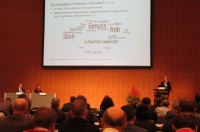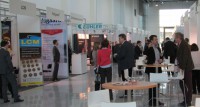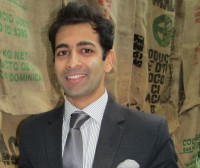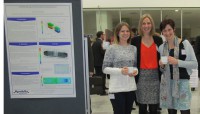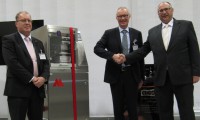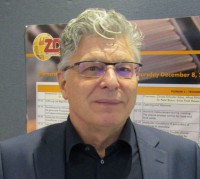ZDS - Zentralfachschule der Deutschen Süßwarenwirtschaft e. V.
Industry meeting with addictive potential
More than 350 participants from 20 countries, over 50 companies exhibiting, and 33 prominent speakers – these are the figures from the 21st Choco Tec congress, which recently took place in Cologne. During the three-day event, visitors gained insight into the latest developments in science and technology revolving around cocoa and chocolate.
By Dr. Bernhard Reichenbach
Mineral oils, metal grit, and fragments of plastic, glass and the like are the natural enemies of chocolate makers, as none of these are welcome additions to their products. Protecting the consumer is always the first priority. However, in order to combat these enemies effectively, one must get to know them first. This “introduction” was made possible by the ZDS (Central College of the German Confectionery Industry), organisers of the Choco Tec congress, which recently took place in Cologne and featured over 350 international participants from all sectors of chocolate making.
The complex ”Food Safety and Quality Assurance” was just some of the many issues discussed at the speaking events, which are a central meeting point for the cocoa and chocolate processing industry as well as corresponding food science and research entities. Other topics dealt with in 34 seminars held by prominent international scientists and industry insiders included markets and trends, procedural and process methods, chemical analysis, sustainability and health aspects.
Efficient cocoa mills without hard metal tools
During the introduction, Richard Scobey, President of the World Cocoa Foundation, promoted the ”Cocoa Action Strategy” and the industry‘s corresponding global sustainability initiative in the cocoa sector. Through education and assistance measures –including the improvement of soil and plants as well as planting and harvest methods – the following critical problems should be abated: sinking crop yields, impoverishment of cocoa farmers, child labour, crop diseases and pests, advancing deforestation as a result of agricultural production, as well as climate change, due to which many areas are no longer suitable for cocoa cultivation.
Devashish Tikekar from Barry Callebaut gave a spirited presentation about the demands of the Asian chocolate market – a market that “could explode.” While Europe makes up 42% of global sales volume, Asia makes up just 4% despite having a much larger population. However, in this “difficult” market one must overcome diverse political, economic, social and legal problems. “Chocolate, for example, is comparatively expensive in Asia – a bar costs roughly 5 euros in India; it could be made much less expensive through efficient local production.”
Dr. Gertrud Bauermeister from Netzsch Feinmahltechnik addressed the aforementioned problem with regard to iron, tungsten and cobalt in the cocoa grinding process. She demonstrated that while using abrasion-resistant hard metals instead of tempered steel for the grinding tools in
fly cutter and ball mills does increase service life significantly, the end result is that instead of iron, (too) high levels of hard metal elements are introduced into the ground cocoa - and ultimately into the chocolate. Optimised mill construction, which does not employ hard metal parts, like horizontal instead of vertical mill containers, should solve this problem.
Prof. Reinhard Matissek, Director of the LCI – Food Chemistry Institute, discussed another problem in his lecture on ”MOSH/MOAH Minimisation in Food”. He mentioned that mineral oil components, which can be carcinogenic and mutagenic, can find their way into food in various ways and accumulate in the body following ingestion. The seminar focussed primarily on MOSH (mineral oil saturated hydrocarbons) as well as MOAH (mineral oil aromatic hydrocarbons). According to Prof. Matissek, the main point of entry is not caused by the food industry, but rather from recycled cartons, paper and cardboard as well as printed jute sacks into raw materials and into the food itself. “Manufacturers have already optimised many food packages for the end consumer, and in so doing have reduced the migration of mineral oil component migration. More effective, however, would be if newspaper printers, for example, used mineral oil-free ink colours in order to eliminate the introduction of these components into the paper recycling loop,” said Prof. Matissek.
Detecting foreign bodies with ultrasound
Prof. Malcolm Povey from the University of Leeds discussed a new solution regarding undesired particles in his seminar on ”Using ultrasound spectroscopy to detect foreign bodies in chocolate products.” He showed that foreign bodies like plastic spall or fragments of bones or nut shells can be identified using an inexpensive, non-invasive ultrasound system. While other detection systems pose problems, the ultrasound system causes no damage and can be used inline for already packaged products like chocolate bars. ”Our solution is a wonderful complement to existing systems,” noted Prof. Povey.
Tobias Franke from the Hochschule Neubrandenburg school identified an innovative business field with future potential in his speech on “Utilisation and potential of 3D printing in the chocolate and confectionery industry.” He made it clear that a standard FLM (Fused Layer Modelling) 3D printer, which costs less than € 3,000, can be adapted for and utilised in the food sector. “This enables the manufacture of individualised chocolate products with a wall thickness of less than 1 mm according to CAD designs or 3D scans for single items and small batches,” the expert explained. ”This allows chocolate manufacturers to expand their assortment of half-finished goods and lets the customer take part, too.” Those who want more information about the 3D topic can attend the first ”International Congress for Additive Manufacturing and 3D Food Printing for the Confectionery and Snack Industry,” which will be held in Cologne from 30-31 January 2017.
In a foyer exhibition that ran parallel to the congress, more than 40 industry companies – confectionery manufacturers as well as suppliers of machines and ingredients – presented to the audience at their informational stands. Many congress participants used with opportunity to gain insight as well as make and maintain contacts.
As part of the congress, the representatives from twelve of the exhibiting companies provided information in a special assembly area with brief presentations about various aspects of chocolate making. The array of topics in this ”industry platform” ranged from caramel trends in chocolate to the cleaning of chocolate moulds and quality control during production.
There was also particular interest for Choco Tec‘s most extensive exhibition to date of informational posters on scientific themes regarding chocolate and its ingredients. In a poster slam, the presenters were able to offer the audience insight into the most important aspects of their scientific research with one-minute summaries and open discussions about their findings. The exhibit with 32 posters in a special foyer area was very well visited and received a positive response from visitors.
Aasted hands over a cold press machine to ZDS
In commemoration of the 100th anniversary of the Aasted company, which was founded in 1917 in Farum, Denmark, Chief Executive Allan Aasted and Peter Meyer, Managing Director of Aasted Germany GmbH, presented a frozen cone-type cold press machine to Andreas Bertram, Managing Director of the ZDS. The machine, which can produce premium precision items like chocolate shells and hollow figures, will be used for educational and demonstration purposes at the ZDS. “It offers the user unlimited freedom to create exact shapes and to determine shell thicknesses with precision – regardless of the viscosity of the mass,” explained Mr. Meyer.
Marco Tibolla, Director of Operations at the Dillenburg plant for the Swiss chocolatier Läderach, was also present at the ceremony. The company has been using the frozen cone line at its Dillenburg plant for several months after it replaced an older piece of equipment. ”We are very pleased with our new solution, because we are able to obtain significantly better quality with it now,” explained the production expert.
Promoting the networking opportunities characteristic of Choco Tec, a festive dinner for the congress participants was held at the world-famous chocolate museum on the banks of the Rhine River in Cologne. The highlight was an artistically arranged chocolate buffet.

